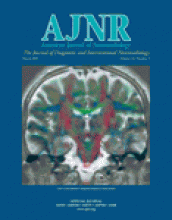In 1986, Modic et al (1) reported that 0.6-T MR imaging of the spine was equivalent to CT and myelography in the diagnosis of lumbar canal stenosis and herniated disk disease. They concluded that MR imaging could be viewed as an alternative to myelography. Since then, a steady decline has occurred in the number of myelograms obtained throughout the country. Speakers at national meetings discuss myelography “for historic interest only” or in the context of “malpractice” to discourage the practice of myelography. Institutions admitting to performing myelography are viewed with suspicion. This is unfortunate, because many institutions abandoned myelography in favor of MR imaging despite a paucity of good clinical studies comparing the two techniques. Neuroradiology fellows are no longer adequately trained in the techniques of myelography or the interpretation of myelograms.
A quality myelographic examination includes the combination of fluoroscopic observation, filming, thin-section CT, and use of contrast agent to exclude higher lesions. Many sites drop one or multiple components, decreasing the sensitivity and specificity of the examination and reducing the potential benefits. Advances in multidector CT with capabilities to acquire isotropic pixels and multiplanar reformats increase the resolution of the study far beyond that of MR imaging and superior to that of conventional CT. Perhaps studies comparing myelography to MR imaging have to be repeated with the addition of this new technology.
Despite advances in MR imaging of the spine, pulse sequences, and coil design that have been accomplished during the 16 years since the article by Modic et al was published, we have always found myelography (fluoroscopic observation, filming, and thin-section CT) to be helpful in the presurgical evaluation of degenerative diseases of the cervical and lumbar spine. The MR imaging examination is sometimes indeterminate and nondiagnostic and often shows many abnormalities that are difficult to correlate with clinical data. MR myelography is disappointing because of the lack of resolution to reliably diagnose root compression and the inability to provide dynamic and functional information. The myelogram best shows whether the changes seen on MR images result in nerve root compression or obstruction to the flow of contrast material. Sometimes it is the fluoroscopic impression or plain myelographic films that are the most diagnostic.
In this issue of the AJNR, Drs. Bartynski and Lin report that conventional myelography is more accurate than MR imaging or follow-up CT for detecting nerve root compression in the lateral recess. Conventional myelography correctly predicted impingement in 93% to 95% of the lateral recesses, whereas MR imaging underestimated root compression in 28% to 29% and follow-up CT underestimated root compression in 38% of the lateral recesses. Despite the shortcomings of the article, we agree with the conclusion presented by Bartynski and Lin that a myelographic study is useful for cases in which a strong clinical suspicion of nerve root compression is present and the MR images do not show the lesion or are not adequate to make this determination.
The use of surgical reports to confirm lateral recess compression is problematic; surgical impressions can be both biased and unreliable. In this article, the surgeons reported significant compression at every lateral recess explored (58 of 58 lateral recesses). This subjective assessment may have the effect of increasing the apparent sensitivity and specificity of myelography. Also, there is a high likelihood of selection bias; patients for whom there was a strong clinical suspicion of lateral recess syndrome who had nondiagnostic MR images were more likely to undergo myelography. Patients most likely to have lesions not visible on MR images underwent myelography; most patients with obvious lesions on MR images would not have undergone myelography.
Most surgeons recognize the superiority of CT myelography in visualizing bony pathologic abnormality in both the cervical and lumbar spine. However, MR imaging is a better screening study because it is less invasive, less expensive, and less labor intensive than is myelography. In most cases, MR imaging adequately defines the pathologic abnormality and allows for sound surgical decision making. Obtaining both studies for every surgical patient is not cost-effective. In clinical practice, surgeons request myelography for cases in which nerve root compression is strongly clinically suspected but for which MR imaging has failed to confirm the suspicion. The article by Bartynski and Lin supports the judicious use of myelography in such cases and emphasizes the need to train our neuroradiology fellows in the proper techniques of myelography and the interpretation of myelograms.
- Copyright © American Society of Neuroradiology












